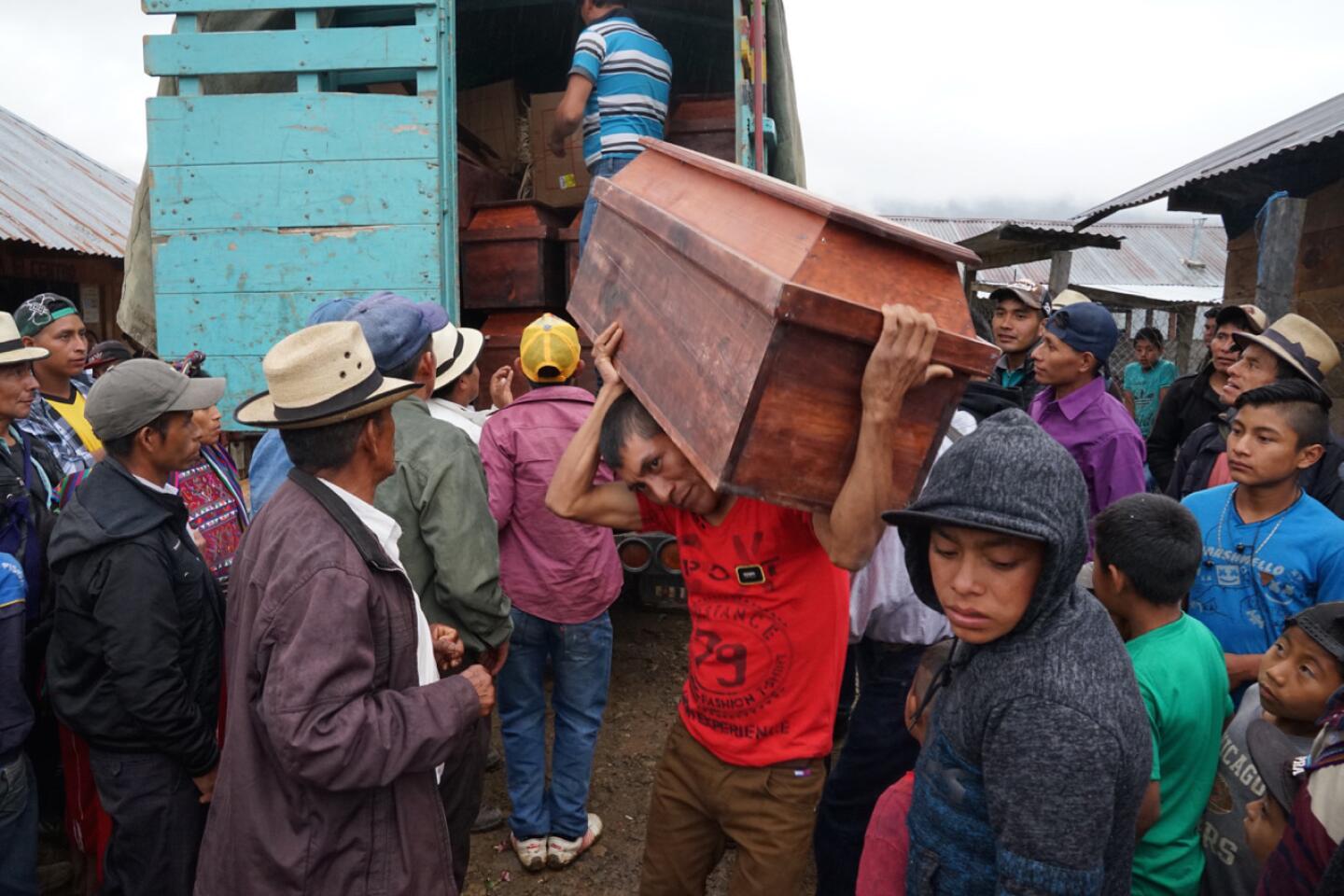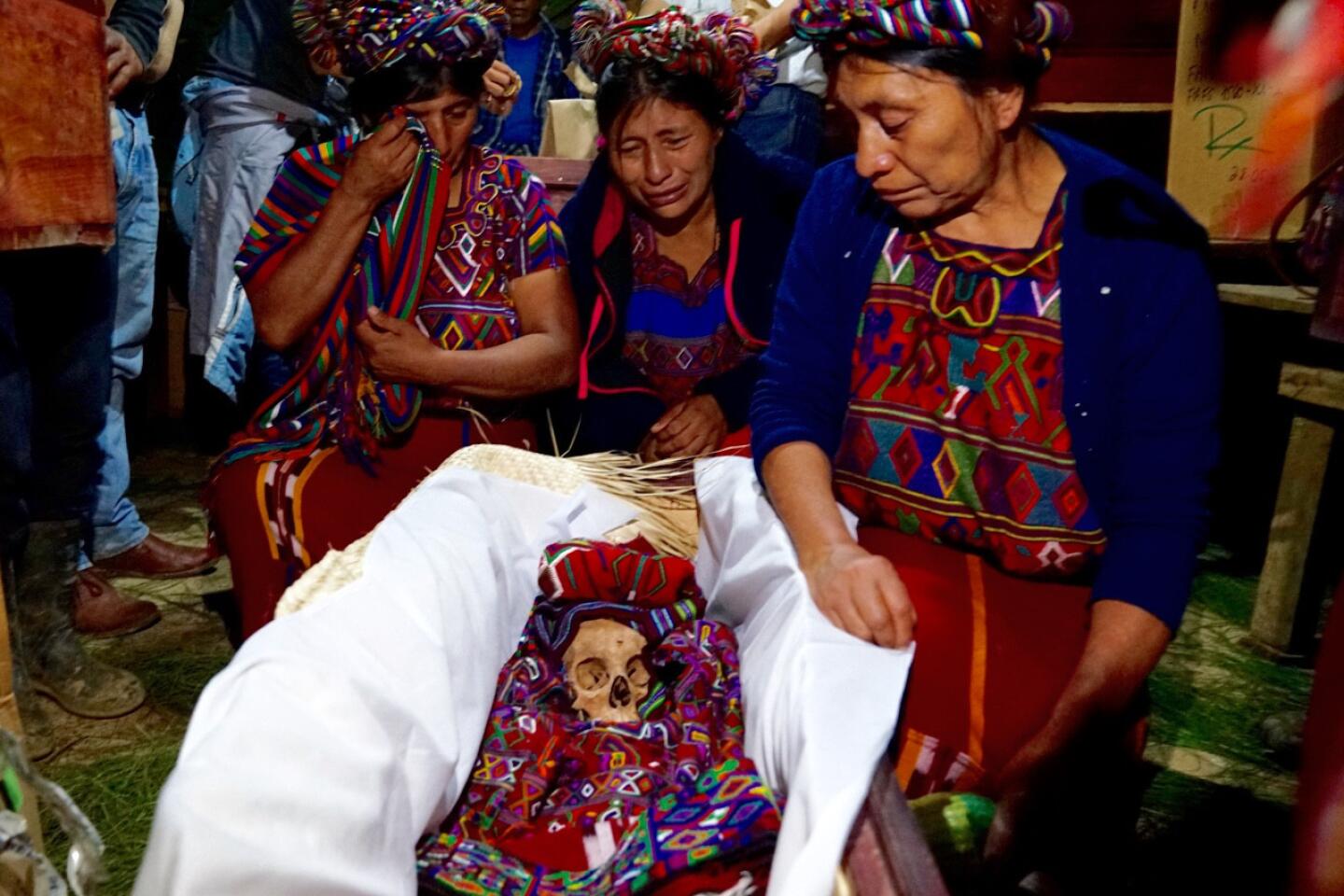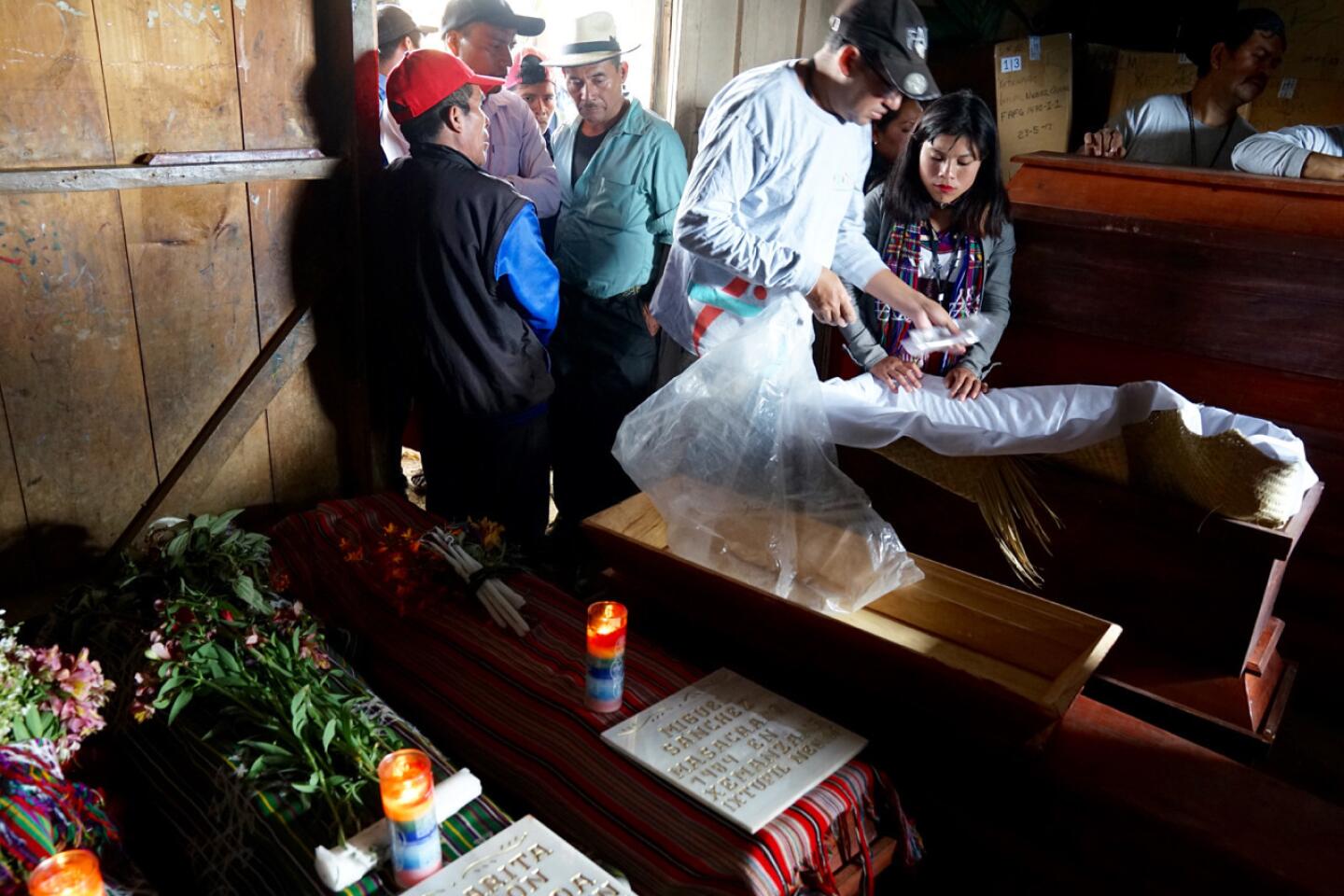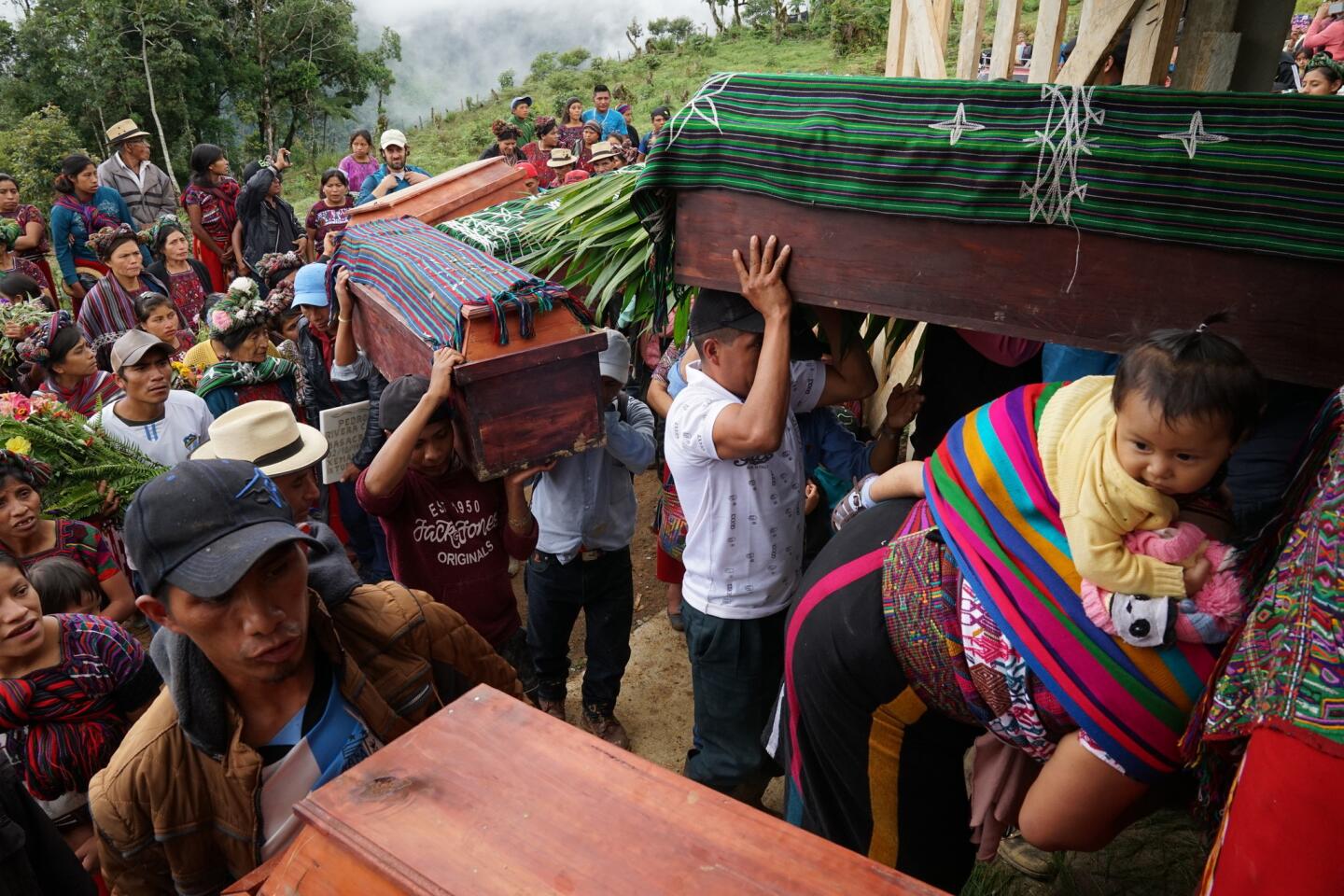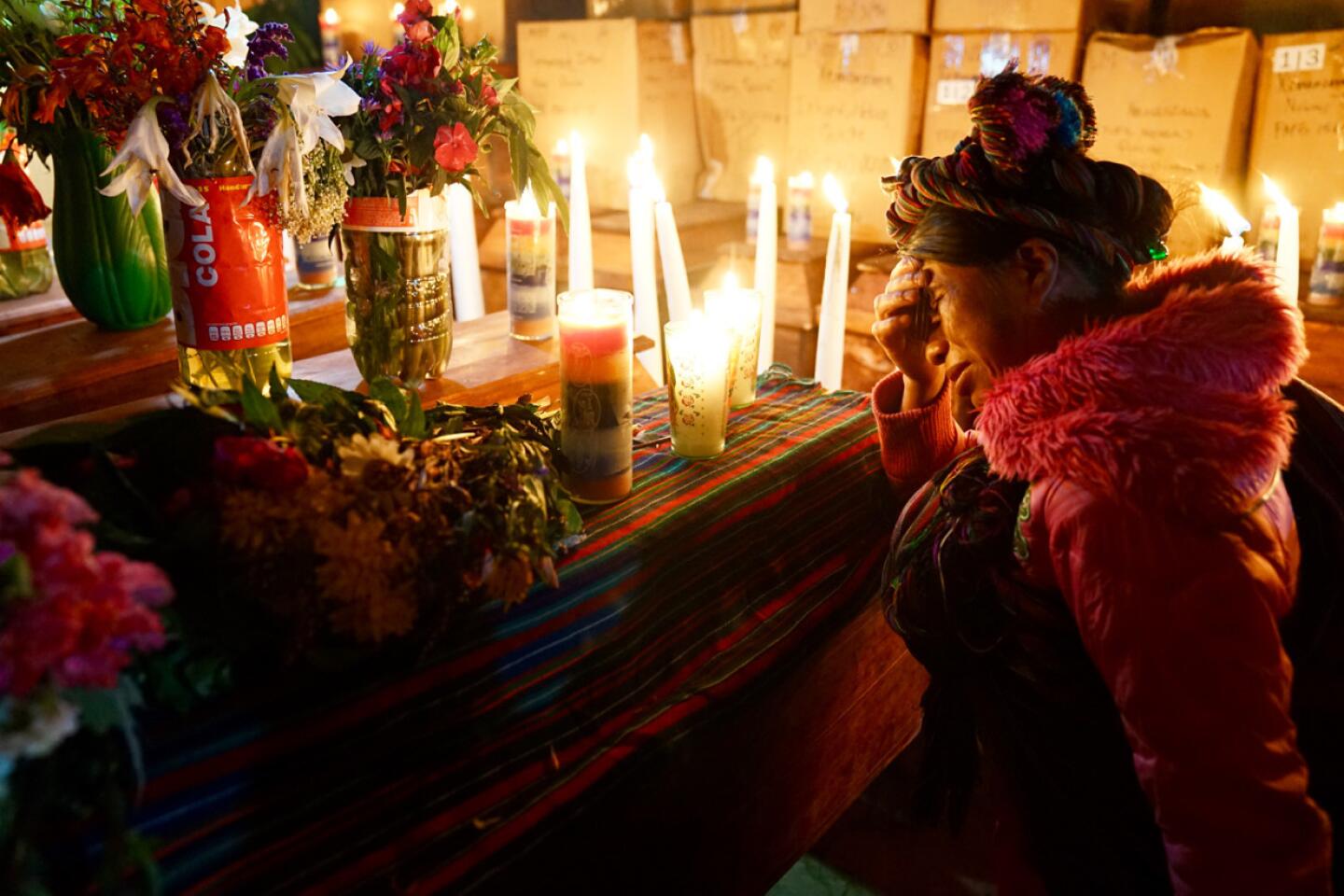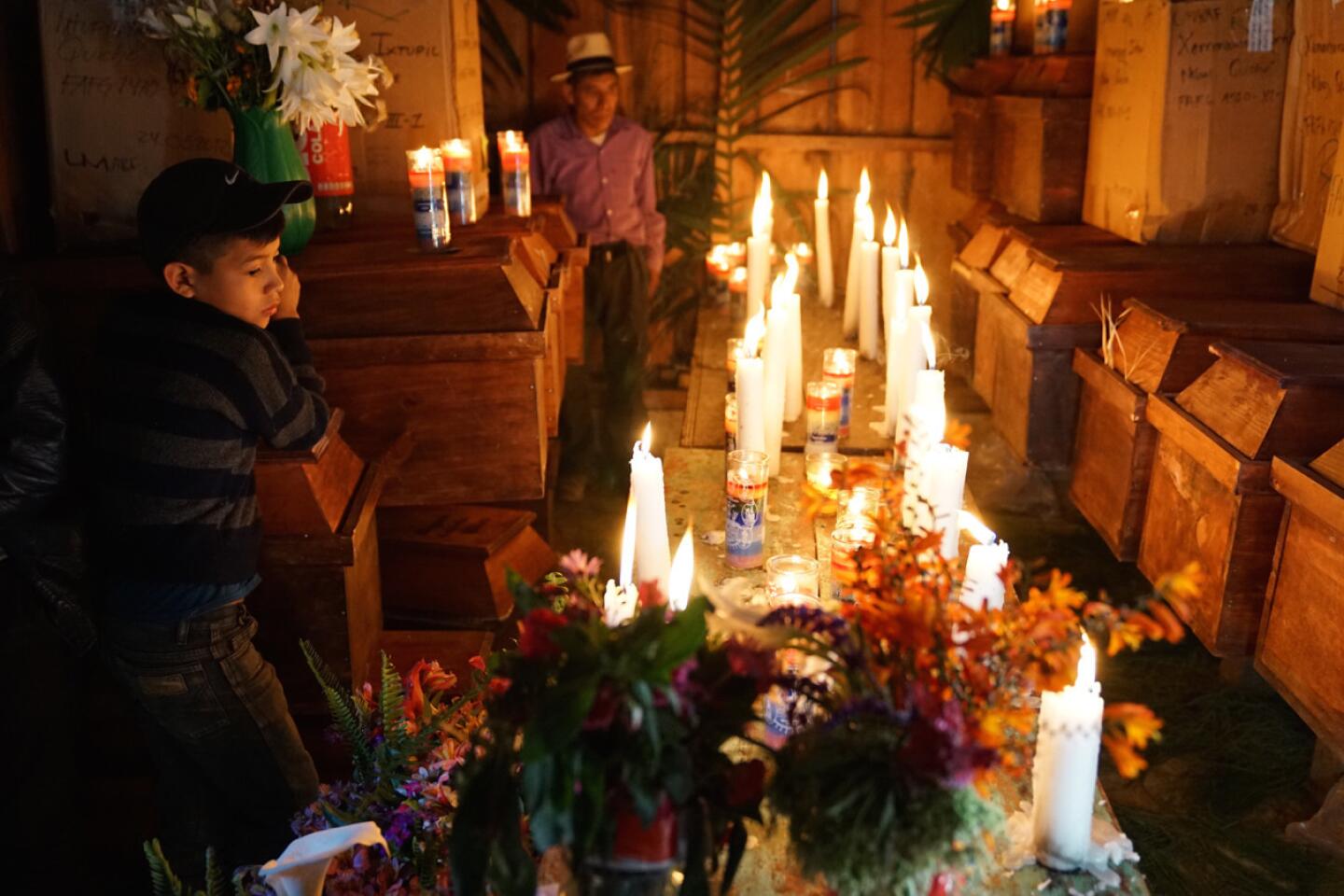After three decades, a Guatemalan village ravaged by war brings home its dead

Ixil Mayas were persecuted and killed during Guatemala’s military rule in the 1980s. The remains of some Ixil Mayas were returned in August to their village, Ixtupil, for burial.
- Share via
Reporting from Ixtupil, Guatemala — The daughters of Teresa Lopez Perez sought a proper farewell for their mother on familiar ground, not the hurried burial she had been given decades earlier under military bombardment in the hills.
With gentle tucks and pulls, the sisters wrapped her in vivid Maya attire — an embroidered blouse, or huipil, a hand-woven sash, or faja, and a traditional shawl.
The luminous garments cloaked their mother’s bare bones — vestiges of vertebrae, limbs and other fragments.
Finally, they readied a multicolored headdress and meticulously positioned it on their mother’s bare skull.
She had been dead for almost 35 years, killed during the darkest period of Guatemala’s long civil war. The sisters sobbed over the remains, now encased in resplendent hues, set upon a white sheet in a wooden casket.
“This is a sad day,” Catarina Raymundo said. “But at least my mother is home again. She is no longer alone.”
The return of Teresa Lopez Perez last month to this fog-enshrouded hamlet is part of a campaign to recuperate memory throughout this Central American nation, where more than 200,000 people, mostly civilians, died in a conflict that erupted in the 1960s and formally ended with a 1996 peace pact.
In the name of national healing, a massive effort to find clandestine graves, exhume the dead and reclaim their identities has gradually yielded results: the identification of 3,500 bodies during the last two decades through DNA analysis, interviews with survivors and examination of recovered clothing and other artifacts. An additional 4,500 have been recovered but remain unidentified, among the almost 50,000 Guatemalans “disappeared” during the war.
“Families continue living with the daily pain of the absence and lack of knowledge of the whereabouts of their loved ones,” said Francesco Panetta of the International Committee of the Red Cross, which has aided in the effort.
No group endured more during the war than the Ixil, an indigenous Maya people of about 100,000 clustered here in northwestern Guatemala’s Quiche province. The Guatemalan military viewed Mayas generally and the Ixil specifically as the “internal enemy,” a support and recruitment base for left-wing guerrillas, according to a 1999 report from a United Nations-backed truth panel.
Guatemalan troops, using aerial assaults and other scorched-earth tactics, razed as many as 90% of all Ixil villages and bombed fleeing civilians, concluded the Commission for Historical Clarification — which found that security forces committed “acts of genocide” against the Maya population from 1981 to 1983, the war’s most brutal era.
Lopez, her seven children and most of the other residents of their village, Ixtupil, fled in October 1983 to the mountains. Along with Lopez, three of her sons and a daughter — ages 5 to 12 — were killed. With their father estranged from the family, Catarina Raymundo, the eldest child, who was 13 at the time, and two sisters found tenuous haven for years with other families away from their razed village.
“My sisters and I were left alone,” she recalled. “There was no one to care for us.”
She carried the memory of watching villagers bury her mother and siblings in makeshift graves in a remote area called Xemanzana.
In 2012 and 2013, the elders of Ixtupil led forensic experts to the gravesites that they remembered. The skeletons of 47 victims — men and women, boys and girls, infants, adolescents and adults — were exhumed and driven over steep, dirt roads to the town of Santa Maria Nebaj and eventually to a lab in Guatemala City for forensic examination.
Most of the skeletons were incomplete. At least eight showed evidence of bullet wounds, according to forensic records. One man had suffered a slit throat, another a machete wound in his neck. Villagers told investigators that they had originally found one of the bodies tied to a tree, and another shot and hung from a roof beam, his hands bound.
In most cases, the causes of death were never determined. Disease, lack of nutrition and exposure to the elements exacted a major toll.
“These civilians suffered from the trauma of bombardment, of being attacked, of escaping to the mountains,” said Jose Samuel Suasnavar, deputy director of the nonprofit Guatemalan Forensic Anthropology Foundation, which oversaw the exhumations and investigation.
The testing stretched on for several years. Of the 47 sets of remains, only 14 were positively identified.
Now all of them — the named and the nameless — were coming home.
::
In the late afternoon of Aug. 7, a truck with blue-painted side panels and a tarpaulin shielding its cargo rumbled into Ixtupil — past the rickety wood-and-adobe homes, narrow tracts of corn and beans, grazing cows and goats, and curious villagers gathered along the cracked roads — and came to a stop outside the village school.
Under a steady rain, the men of Ixtupil unloaded 47 empty caskets — many sized for children — and passed them fire-brigade style to a community center that had been transformed into a makeshift funeral home, flowers and candles adorning tables, pine needles spread on the earthen floor, and garlands of palm strung along the walls.
An hour later, a second truck arrived carrying 47 marble headstones and 47 cardboard boxes.
Carved into the headstone of each identified victim was an approximate date of death and the word “Massacred.”
Only 14 had names, the rest only number codes corresponding to case files.
Staffers from the forensic foundation and volunteers from the village stacked the boxes and the headstones in the community center alongside the coffins.
Villagers crammed inside the building or peered through windows as children scampered about.
The town mayor and other dignitaries delivered addresses honoring the dead as a recorded marimba track droned in the background.
Some villagers embraced the headstones.
“My mother died from hunger,” said Diego Brito Raymundo, who held the slab bearing her name, Petrona Raymundo.
She was about his age, 40, when she perished in the hills, on the run. He never knew her.
Her buried body had been wrapped in a poncho and, in Maya tradition, a porcelain cup had been left in her grave for use in the afterlife.
For some survivors, grief mixed with fierce anger at the Guatemalan state — not only for the unpunished mass killings, but also for the lack of war reparations and what villagers contend is ongoing neglect of one of the nation’s most impoverished regions.
“The government has done nothing for us,” said the 60-year-old mayor, Bernardo Marcos, wearing a straw hat and seated amid the coffins and stacked boxes of remains. “They massacred our people, they burned our homes, they even killed our animals. And they’ve helped us with nothing. We will not forget our dead, our families.”
He too had lost relatives, including a sister, and said that in 1982 he fled Ixtupil and didn’t return for 17 years.
After dusk, the process of returning identified remains to families commenced. A speaker called out the first of the 14 names of the known victims.
The family came forward as forensic staffers unsealed the first cardboard box and removed the plastic sacks and brown paper bags that held the remains.
During the next several hours, the same process was repeated 14 times.
With practiced hands, the workers removed the skulls, other bones and remnants of clothing, and placed them in the coffins, endeavoring to achieve the correct anatomical alignment. Dust and the smallest bits were spilled into the caskets.
Each family patiently awaited its turn. For many, this was the first encounter with long-lost grandparents, uncles, aunts and cousins.
It was late in the evening when the family of Teresa Lopez Perez was called. The three sisters wanted a decent funeral presentation. Swathing their mother’s remnants with the ancestral cloaks provided some measure of relief.
The daughters knelt beside the remains and said a prayer.
Finally, the casket was closed on what was left of Lopez, mother of seven, native of Ixtupil, no longer an anonymous casualty.
After all 14 known victims were placed in coffins, the forensic workers turned attention to the unknown. There was a casket for each. When the smaller coffins ran out, several child victims had to be placed in adult-sized ones.
The hope is that all may be identified some day through DNA matches.
Lopez’s daughters said they believed that some of the unidentified remains were those of their four siblings.
::
That evening, relatives carried the caskets of their identified loved ones back to homes for memorial services.
At Catarina Raymundo’s simple residence, across the dirt track from the community center, mourners sat on chairs and benches, sipping soft drinks. Flowers, a candle and an embroidered cloth topped the coffin of her mother. A Christian band maintained a melancholy cumbia beat while female singers alternated doleful religious ballads. One of her five children helped serve chicken soup to mourners.
There were many tears, but also a few smiles, some memories of better times exchanged.
Adorning one wall were a black-and-white photograph of Raymundo’s grandfather and some images of in-laws.
“I don’t have a single photo of my mother,” Raymundo said. “How sad. I don’t have anything of her.”
Mourners stayed up all night amid a heavy rain, and townsfolk honored the dead by setting off fireworks almost till dawn.
As roosters crowed to a sun-splashed morning, there was another round of speeches, and more fireworks. Then men began hoisting the coffins on their shoulders down the muddy road to the cemetery — where a concrete mausoleum had been constructed. It contained 47 individual niches.
The structure dominated the small cemetery, which consisted of some toppled wooden crosses scattered in a patch of land.
Girls and women in their Sunday best bore flowers or candles in the procession. The whole village turned out.
Relatives laid the coffins — many covered with candles and fabrics — on the ground outside.
Soon, workmen would seal the vaults and attach the headstones.
As the rain intensified, a group of villagers ignited a bonfire, after a Maya ritual, and tossed in red, white, blue and yellow candles, representing the four seasons.
The daughters of Teresa Lopez Perez trudged back up the muddy hill with the other families, the collective memory of the departed now partially restored, their remains no longer forsaken in the Ixil highlands.
Special correspondents Liliana Nieto del Rio in Ixtupil and Cecilia Sanchez in Mexico City contributed to this report.
Twitter: @PmcdonnellLAT
More to Read
Sign up for Essential California
The most important California stories and recommendations in your inbox every morning.
You may occasionally receive promotional content from the Los Angeles Times.
